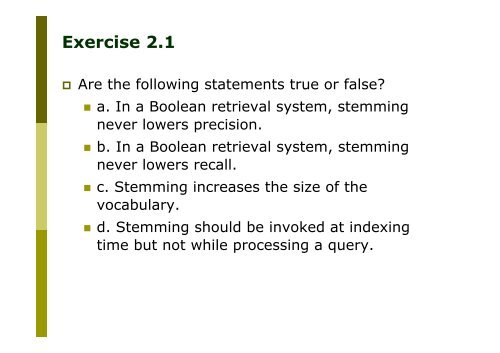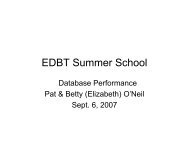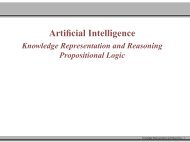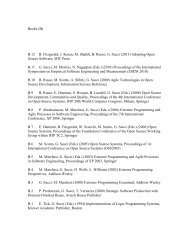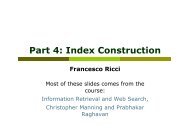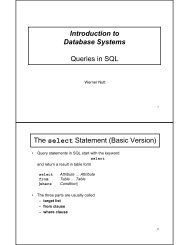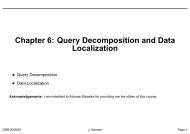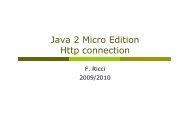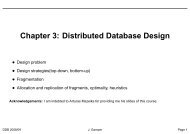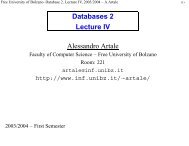You also want an ePaper? Increase the reach of your titles
YUMPU automatically turns print PDFs into web optimized ePapers that Google loves.
<strong>Exercise</strong> <strong>2.1</strong><br />
� Are the following statements true or false?<br />
� a. In a Boolean retrieval system, stemming<br />
never lowers precision.<br />
� b. In a Boolean retrieval system, stemming<br />
never lowers recall.<br />
� c. Stemming increases the size of the<br />
vocabulary.<br />
� d. Stemming should be invoked at indexing<br />
time but not while processing a query.
<strong>Exercise</strong> 2.2<br />
� Suggest what normalized form should be used for<br />
these words (including the word itself as a<br />
possibility):<br />
� a. ’Cos<br />
� b. Shi’ite<br />
� c. cont’d<br />
� d. Hawai’i<br />
� e. O’Rourke
<strong>Exercise</strong> 2.3<br />
� The following pairs of words are stemmed to the<br />
same form by the Porter stemmer.<br />
� Which pairs would you argue shouldn’t be<br />
conflated. Give your reasoning.<br />
� a. abandon/abandonment<br />
� b. absorbency/absorbent<br />
� c. marketing/markets<br />
� d. university/universe<br />
� e. volume/volumes
<strong>Exercise</strong> 2.4<br />
� For the Porter stemmer rule group shown in<br />
formula (<strong>2.1</strong>):<br />
� a. What is the purpose of including an identity<br />
rule such as SS →SS?<br />
� b. Applying just this rule group, what will the<br />
following words be stemmed to?<br />
� circus canaries boss<br />
� c. What rule should be added to correctly stem<br />
pony?<br />
� d. The stemming for ponies and pony might<br />
seem strange. Does it have a deleterious effect<br />
on retrieval? Why or why not?
<strong>Exercise</strong> 2.8<br />
� Assume a biword index. Give an example of a<br />
document which will be returned for a query of<br />
'New York University' but is actually a false<br />
positive which should not be returned.
<strong>Exercise</strong> 2.9<br />
� Shown below is a portion of a positional index in the format:<br />
term: doc1: position1, position2, . . . ; doc2: position1, position2,<br />
. . . ; etc.<br />
angels: 2: 36,174,252,651; 4: 12,22,102,432; 7: 17;<br />
fools: 2: 1,17,74,222; 4: 8,78,108,458; 7: 3,13,23,193;<br />
fear: 2: 87,704,722,901; 4: 13,43,113,433; 7: 18,328,528;<br />
in: 2: 3,37,76,444,851; 4: 10,20,110,470,500; 7: 5,15,25,195;<br />
rush: 2: 2,66,194,321,702; 4: 9,69,149,429,569; 7: 4,14,404;<br />
to: 2: 47,86,234,999; 4: 14,24,774,944; 7: 199,319,599,709;<br />
tread: 2: 57,94,333; 4: 15,35,155; 7: 20,320;<br />
where: 2: 67,124,393,1001; 4: 11,41,101,421,431; 7:<br />
16,36,736;<br />
� Which document(s) if any match each of the following queries,<br />
where each expression within quotes is a phrase query?<br />
� a. “fools rush in”<br />
� b. “fools rush in” AND “angels fear to tread”
<strong>Exercise</strong> <strong>2.1</strong>0<br />
� Consider the following fragment of a positional index with<br />
the format:<br />
� word: document: [position, position, . . .]; document:<br />
[position, . . .] . . .<br />
Gates: 1: [3]; 2: [6]; 3: [2,17]; 4: [1];<br />
IBM: 4: [3]; 7: [14];<br />
Microsoft: 1: [1]; 2: [1,21]; 3: [3]; 5: [16,22,51];<br />
� The /k operator, word1 /k word2 finds occurrences of<br />
word1 within k words of word2 (on either side), where k is<br />
a positive integer argument. Thus k = 1 demands that<br />
word1 be adjacent to word2.<br />
� a. Describe the set of documents that satisfy the query<br />
Gates /2 Microsoft.<br />
� b. Describe each set of values for k for which the query<br />
Gates /k Microsoft returns a different set of documents<br />
as the answer.
<strong>Exercise</strong> <strong>2.1</strong>1<br />
� Consider the general procedure for merging two positional<br />
postings lists for a given document, to determine the<br />
document positions where a document satisfies a /k clause<br />
(in general there can be multiple positions at which each<br />
term occurs in a single document).<br />
� We begin with a pointer to the position of occurrence of<br />
each term and move each pointer along the list of<br />
occurrences in the document, checking as we do so<br />
whether we have a hit for /k. Each move of either pointer<br />
counts as a step. Let L denote the total number of<br />
occurrences of the two terms in the document.<br />
� What is the big-O complexity of the merge procedure, if we<br />
wish to have postings including positions in the result?
<strong>Exercise</strong> 3.2, 3.3, 3.5<br />
� Write down the entries in the permuterm index<br />
dictionary that are generated by the term mama.<br />
� If you wanted to search for s*ng in a permuterm<br />
wildcard index, what key(s) would one do the<br />
lookup on?<br />
� Consider again the query fi*mo*er from Section<br />
3.<strong>2.1</strong>. What Boolean query on a bigram index<br />
would be generated for this query? Can you think<br />
of a term that matches the permuterm query in<br />
Section 3.<strong>2.1</strong>, but does not satisfy this Boolean<br />
query?
<strong>Exercise</strong> 3.7, 3.10<br />
� If |si| denotes the length of string si, show that<br />
the edit distance between s1 and s2 is never<br />
more than max{|s1|, |s2|}.<br />
� Compute the Jaccard coefficients between the<br />
query bord and each of the terms that contain<br />
the bigram 'or', as below:<br />
or border lord morbid sordid


